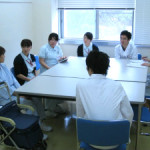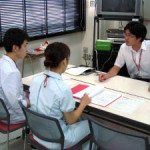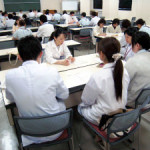Step 4 “Integration” is a step where students gain the ability to holistically assess the patient/service user and create a plan for medical examination/care through patient/service user-centric IPW by integrating what they have learned about IPE since Step 1 with what they have learned in each specialized area.
Under Step 4, students will create hospital discharge plans for patients under various cases (cerebral infarction, HIV, pediatric, myocardial infarction, diabetes, and colon cancer) through three-day group work in late September. During that process, students will work on two major exercises: interviewing simulated patients and service users on the first day and consulting with each professional on the second day. Students will then present and discuss in front of other students, faculty members, and simulated patients at the presentation session on the third day, which is the last day, to identify next study tasks.
*The following describes the actual implementation for the fiscal year 2013.
[Time and Date]
Group 1: September 18 (Wed) to 20 (Fri)
Group 2: September 24 (Tue) to 26 (Thurs)
*First to fifth periods on the first day. Third to fifth periods on the second and third day. Two rounds were conducted by dividing students into two groups due to a large number of students.
[Student]
A total of 243 students including 123 seniors from the School of Medicine, 85 seniors from the School of Nursing, and 35 seniors from the Faculty of Pharmaceutical Sciences
*18 groups of 6 to 7 students from various undergraduate schools were created (× 2 Groups). Cases included cerebral infarction, HIV, pediatric, myocardial infarction, diabetes, and colon cancer.
[Learning Objectives]
- To apply the latest expertise to hospital discharge plan with a help of professionals and/or faculty members
- To work together with team members based on the characteristics and limitations of their expertise
- To assess the situation of the team and determine own action in order to achieve team’s goal
- To work as a team to prepare a hospital discharge plan based on a holistic assessment of the patient/service user
- To create a friendly atmosphere to have discussions with team members and other various professionals involved on the basis of good human relationships
- To explain from the standpoint of student the scope and challenges regarding what can be done with the expertise of own profession and technology
To be able to conduct interviews with simulated patients and service users, make a holistic assessment based on the information obtained from the interview as well as medical chart, and identify issues to be resolved.
- To be able to communicate with the patients and service users with empathy.
- To be able to obtain necessary information about the patient and service users from the perspective of each profession.
- To be able to holistically assess the patient and service users and identify issues to be resolved.
To be able to create a hospital discharge plan by consulting with each professional regarding the issues with the simulated patient/service user.
- To be able to consult with appropriate professionals regarding the issues with the simulated patient/service user.
- To be able to create a hospital discharge plan for the simulated patient and service user.
[Learning Contents]
| Schedule | Content and Method of Study |
|---|---|
| Day 1 9/18 or 9/24 First to second period |
Pre-test (on the assigned case, what students have learned under the IPE) Inohana IPE Step 4 orientation Lecture: Hospital Discharge Plan and Support Watch a teaching material DVD: “When to Decide, When it Gets Decided” Lecture: Make a Decision by Discussing and Consulting—Conference and Consultation Group work: Share the previous learning, identify the issues to overcome before hospital discharge, and consider questions to ask the simulated patient |
| Day 1 Third to fifth period |
Exercise 1: Initial Interview with the Simulated Patient (understanding of the patient /service user) Group work: Assess, clarify the issues, and set goals Exercise 1: Second Interview with the Simulated Patient (set and share the goals) and feedback from the simulated patient Group work: Decide on goals and plan to consult with professionals |
| Day 2 9/19 or 9/25 Third to fifth period |
Exercise 2: Consulting with Professionals Group work: Create a hospital discharge plan and prepare the presentation. |
| 3Day 3 9/22 or 9/29 Third period on |
Study Outcome Presentation |
[A Look at the Class]
 Interview with the simulated patient
Interview with the simulated patient
Students interview a simulated patient to gather information on patient’s current condition, life before the hospitalization, and preference on life after the hospitalization and how to lead life in the future in order to create a hospital discharge plan. Group work
Group work
Based on the interview conducted twice, students share each other’s knowledge and try to formulate a plan that would be the best for the patient/service user him/herself as well as his/her family by incorporating the approach to deal with the disease, communicate with the family, and utilize social security systems. Consultation with professionals
Consultation with professionals
Students seek opinions from professionals working at the frontline called Chiba University Hospital as to how their plan looks from the eye of professionals and whether there is a better approach. This is a pharmacist. This is a physician. Students seek advice from the specialist for each disease.
This is a physician. Students seek advice from the specialist for each disease. A total of 29 (58 in two days) physicians, nurses, pharmacists, physical therapists, occupational therapists, speech therapists, medical social workers, registered dietitians, counselors, and genetic counselors were asked to cooperate in order to make this a good education for students. Students finalize the hospital discharge plan by referring to opinions of each specialist and share it at the presentation.
A total of 29 (58 in two days) physicians, nurses, pharmacists, physical therapists, occupational therapists, speech therapists, medical social workers, registered dietitians, counselors, and genetic counselors were asked to cooperate in order to make this a good education for students. Students finalize the hospital discharge plan by referring to opinions of each specialist and share it at the presentation.